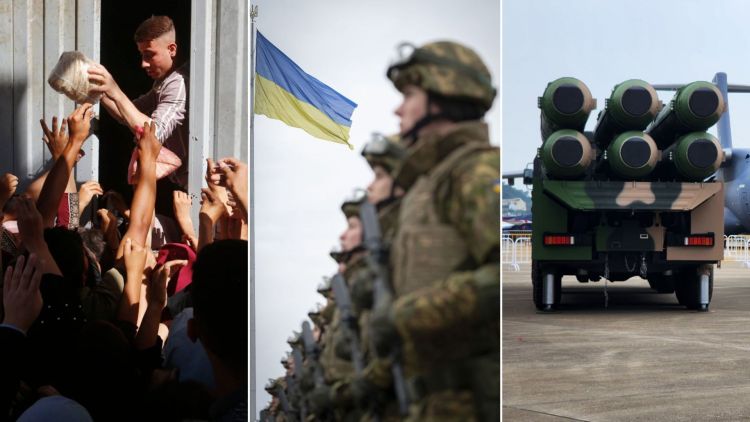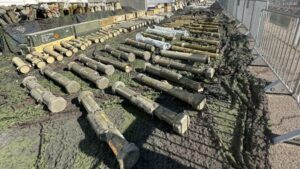Here’s your Tuesday brief: Key defense and global affairs insights to keep you in the know on November 13.
Biden Administration Presses Israel on Gaza Aid
The Biden administration acknowledged Israel’s limited progress in allowing humanitarian aid into Gaza but decided not to restrict arms transfers despite previous threats.
State Department spokesman Vedant Patel stated Tuesday that Israel is not currently violating US laws, which require adherence to international humanitarian standards.
However, Patel emphasized that Israel isn’t being given a “pass,” urging continued improvement in the humanitarian situation.
“We’re not giving Israel a pass,” he said, adding that “we want to see the totality of the humanitarian situation improve, and we think some of these steps will allow the conditions for that to continue to progress.”
Despite US pressure, international aid organizations claim Israel hasn’t met key benchmarks for improving aid access, particularly in northern Gaza, where famine warnings persist.
US officials are cautiously optimistic about new measures, such as opening aid crossings and expanding humanitarian zones, but aid distribution remains hindered by Israeli military restrictions and logistical challenges.
You can watch the full State Department press briefing below.
US Forces Defend Warships, Hit Back Houthis in Yemen
Yemen’s Houthi rebels recently launched a major attack on two American destroyers transiting the Bab al-Mandab Strait, firing drones, ballistic missiles, and cruise missiles.
Fortunately, the warships intercepted and defeated all threats, with no damage or injuries reported, according to Pentagon spokesperson Major General Pat Ryder on Tuesday’s press briefing.
The Houthis also falsely claimed they targeted the USS Abraham Lincoln aircraft carrier.
These attacks are part of a broader surge in regional violence linked to the ongoing conflict in Gaza, with Iran-backed groups in Yemen, Lebanon, Iraq, and Syria escalating their actions.
In response, the US has ramped up its airstrikes on Houthi weapon storage facilities and conducted strikes against Iran-backed groups in Syria to deter further threats.
Russian Forces Push Near Kurakhove with Heavy Armor
Russian troops recently launched a series of mechanized assaults near Kurakhove in western Donetsk Oblast, deploying heavy armored vehicles.
According to the Institute for the Study of War (ISW) on Tuesday, two company-sized attacks involved at least 12 armored vehicles. Ukrainian forces responded with artillery and drones, taking out three tanks and six infantry fighting vehicles.

Further south in Dalne, another Russian assault was recorded with nine armored vehicles. Ukrainian defenses again held strong, destroying two tanks and six armored vehicles.
Russian forces, including units from the 20th Motorized Rifle Division, are aiming to pressure Ukrainian positions and push along strategic highways in the region.
Despite worsening weather, Russian troops continue to advance on multiple fronts, including near Vuhledar and other settlements around Kurakhove.
The ISW warns that further gains could force Ukrainian withdrawals in key areas, potentially giving Russian forces an edge in this part of the conflict.
China Unveils HQ-19 Advanced Missile Defense System at Zhuhai Airshow
For the first time, China’s People’s Liberation Army (PLA) Air Force will showcase its HQ-19 surface-to-air missile system at Airshow China 2024, running from November 12 to 17 in Zhuhai, Guangdong Province.
The HQ-19, China’s latest missile defense system, is designed to intercept ballistic missiles and hypersonic glide vehicles. Its advanced features include “strong defense penetration and countermeasure capabilities,” making it a key player in regional air defense.
Often compared to America’s Terminal High Altitude Area Defense (THAAD) system, the HQ-19 boasts impressive capabilities, including intercepting ballistic missiles both inside and outside Earth’s atmosphere at ranges up to 1,864 miles (3,000 kilometers).
It also features advanced radar with a detection range of 2,485 miles (4,000 kilometers) and can launch missiles at near-vertical angles for maximum efficiency.

Equipped with six interceptor missiles per vehicle, the HQ-19 uses a highly mobile 8×8 wheeled chassis and advanced cold-launch technology.
Originally developed in the late 1990s under China’s 863 Program, the HQ-19 has been fine-tuned through years of testing.
While not yet deployed, it’s designed to counter threats from short to intermediate-range missiles, with potential future upgrades targeting ICBMs.
Analysts believe the system aims to protect critical infrastructure and reinforce China’s missile defense strategy against potential US, Russian, or Indian missile strikes.
Military analyst Zhang Xuefeng, for one, emphasized its importance in countering modern ballistic missile threats, likening its significance to the PLA’s J-20 stealth fighter, the Global Times reported.
Philippines Stands Firm on Maritime Claims
Philippine Defense Secretary Gilberto Teodoro doesn’t expect the incoming Trump administration to demand higher payments for US military protection, citing the shared threat posed by China.
Speaking alongside Australian Defense Minister Richard Marles after an inaugural meeting on Tuesday, Teodoro emphasized the importance of US-Philippine security ties, particularly in countering China’s aggressive activities in the South China Sea.
“We have an interest, both the United States and the Philippines, in ensuring that our partnership continues because — not totally, but principally — … of shared threats,” Teodoro said, the Associated Press quoted. “And that is undoubtedly the overreach and the aggressive and illegal activities of China.”
Marles echoed confidence in America’s continued global leadership, which he said is crucial for maintaining the rules-based order.
Meanwhile, tensions between Manila and Beijing have escalated after Philippine President Ferdinand Marcos Jr. signed two new laws affirming the country’s maritime territories.
China responded with a strong protest, accusing the Philippines of attempting to solidify an “illegal” arbitration ruling through domestic legislation.
Confrontations in the disputed waters have raised fears of potential US involvement in a broader conflict.
Palau Doubles Down on US Alliance, Calls Out China
Palau’s pro-Western President, Surangel Whipps Jr., has secured a second term, winning the November 5 election with 5,626 votes against his brother-in-law, Tommy Remengesau.
Whipps wasted no time reaffirming his commitment to the US and calling out China for its provocative actions, including uninvited vessels in Palau’s waters and naming underwater mountains claimed by the island nation.
“We keep on raising flags and complaining about it, but they keep on sending them,” Whipps told AFP. “They continually don’t respect our sovereignty and our boundaries and just continue to do these activities.”
As a key US ally in the Pacific and one of the few nations recognizing Taiwan’s independence, Palau has faced economic pressure from Beijing, including being blacklisted as a tourist destination.
Whipps has emphasized the importance of US military presence, calling Palau “part of the US homeland” in terms of security, as the island continues to play a strategic role in countering China’s influence.
India Strengthens Space Defense with Military Drill
India just wrapped up its first military space exercise, “Antariksha Abhyas 2024,” held in New Delhi from November 11 to 13.
The exercise aimed to bolster the country’s strategic space capabilities and integrate them into military operations, recognizing that space is becoming an increasingly contested and competitive domain.
The event brought together personnel from India’s military branches, the Defense Space Agency, Defense Research and Development Organization (DRDO), and Indian Space Research Organization (ISRO) to explore how critical space-based assets are for defense and identify potential vulnerabilities.

Chief of Defense Staff General Anil Chauhan highlighted the importance of space as a key enabler for India’s defense and security, emphasizing the need for innovation and collaboration to stay ahead of emerging threats.
“Space, once considered the final frontier is now the critical enabler of India’s defence and security apparatus,” Chauhan said in a press statement. “With its rich legacy of space exploration and growing military capabilities, India is well positioned to navigate the challenges posed to space based capabilities.”



